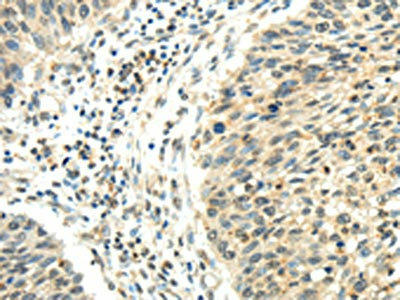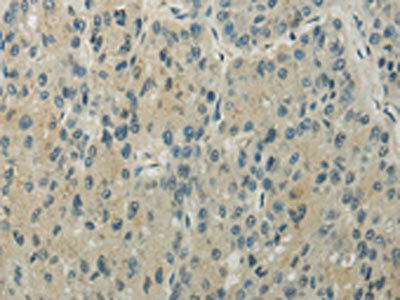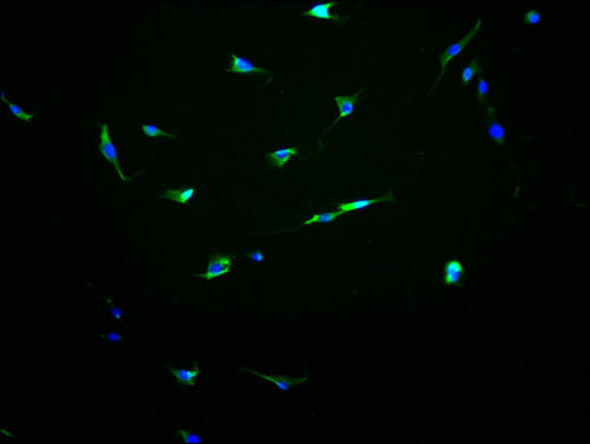Description
| Antibody Name: | RHOU Antibody (PACO20925) |
| Antibody SKU: | PACO20925 |
| Size: | 50ul |
| Host Species: | Rabbit |
| Tested Applications: | ELISA, IHC |
| Recommended Dilutions: | ELISA:1:2000-1:5000, IHC:1:20-1:100 |
| Species Reactivity: | Human |
| Immunogen: | Synthetic peptide of human RHOU |
| Form: | Liquid |
| Storage Buffer: | -20°C, pH7.4 PBS, 0.05% NaN3, 40% Glycerol |
| Purification Method: | Antigen affinity purification |
| Clonality: | Polyclonal |
| Isotype: | IgG |
| Conjugate: | Non-conjugated |
 | The image on the left is immunohistochemistry of paraffin-embedded Human lung cancer tissue using PACO20925(RHOU Antibody) at dilution 1/30, on the right is treated with synthetic peptide. (Original magnification: x200). |
 | The image on the left is immunohistochemistry of paraffin-embedded Human liver cancer tissue using PACO20925(RHOU Antibody) at dilution 1/30, on the right is treated with synthetic peptide. (Original magnification: x200). |
| Background: | This gene encodes a member of the Rho family of GTPases. This protein can activate PAK1 and JNK1, and can induce filopodium formation and stress fiber dissolution. It may also mediate the effects of WNT1 signaling in the regulation of cell morphology, cytoskeletal organization, and cell proliferation. A non-coding transcript variant of this gene results from naturally occurring read-through transcription between this locus and the neighboring DUSP5P (dual specificity phosphatase 5 pseudogene) locus. |
| Synonyms: | ras homolog family member U |
| UniProt Protein Function: | Acts upstream of PAK1 to regulate the actin cytoskeleton, adhesion turnover and increase cell migration. Stimulates quiescent cells to reenter the cell cycle. Has no detectable GTPase activity but its high intrinsic guanine nucleotide exchange activity suggests it is constitutively GTP-bound. Plays a role in the regulation of cell morphology and cytoskeletal organization. Required in the control of cell shape. |
| NCBI Summary: | This gene encodes a member of the Rho family of GTPases. This protein can activate PAK1 and JNK1, and can induce filopodium formation and stress fiber dissolution. It may also mediate the effects of WNT1 signaling in the regulation of cell morphology, cytoskeletal organization, and cell proliferation. A non-coding transcript variant of this gene results from naturally occurring read-through transcription between this locus and the neighboring DUSP5P (dual specificity phosphatase 5 pseudogene) locus.[provided by RefSeq, Mar 2011] |
| UniProt Code: | Q7L0Q8 |
| NCBI GenInfo Identifier: | 11034843 |
| NCBI Gene ID: | 58480 |
| NCBI Accession: | NP_067028.1 |
| UniProt Secondary Accession: | Q7L0Q8,Q59FE9, Q8TDQ2, B1AKN1, |
| UniProt Related Accession: | Q7L0Q8 |
| Molecular Weight: | 22,164 Da |
| NCBI Full Name: | rho-related GTP-binding protein RhoU |
| NCBI Synonym Full Names: | ras homolog family member U |
| NCBI Official Symbol: | RHOU |
| NCBI Official Synonym Symbols: | ARHU; G28K; WRCH1; hG28K; CDC42L1 |
| NCBI Protein Information: | rho-related GTP-binding protein RhoU |
| UniProt Protein Name: | Rho-related GTP-binding protein RhoU |
| UniProt Synonym Protein Names: | CDC42-like GTPase 1; GTP-binding protein-like 1; Rho GTPase-like protein ARHU; Ryu GTPase; Wnt-1 responsive Cdc42 homolog 1; WRCH-1 |
| Protein Family: | Rho-related GTP-binding protein |
| UniProt Gene Name: | RHOU |






